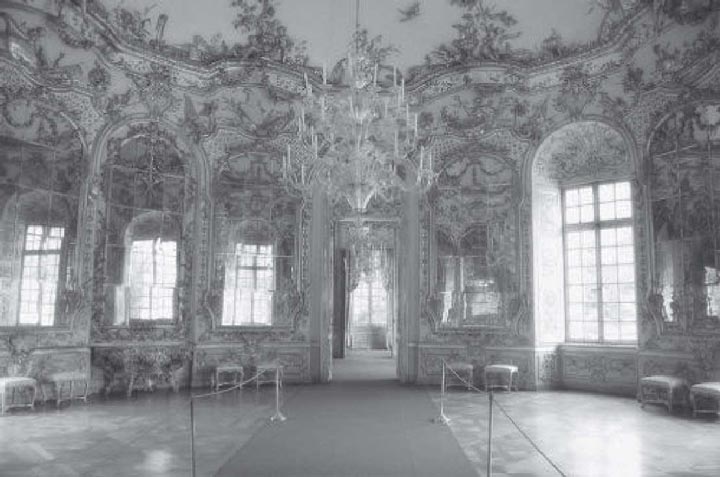






洛可可风格建筑外观
The Rococo style of art emerged in France in the early 18th century as a continuation of the Baroque style, but in contrast to the heavier themes and darker colors of the Baroque, the Rococo was characterized by an opulence, grace, playfulness, and lightness. Its motifs focused on the carefree aristocratic life and on lighthearted romance rather than heroic battles or religious figures; they also revolve heavily around nature and exterior settings. It is known for its feminine curves, intricate designs, and flamboyance. The style was meant to be a reflection of the times, meaning a time that was frivolous, happy and uneventful. The word Rococo was apparently a combination of the French rocaille, or shell, and the Italian barocco, or Baroque style. Due to Rococo love of shell-like curves and focus on decorative arts, some critics used the term to derogatively imply that the style was frivolous or merely fashion.
洛可可风格是18世纪早期在法国兴起的一种风格,是巴洛克风格的延续,但却没有巴洛克那样严肃深沉的主题。洛可可风格纤细、轻巧而烦琐,是无忧无虑的贵族生活的反映。它一改巴洛克的那种爱国、宗教、英雄主义的主题,采用很多自然和户外的元素,喜用曲线、精巧细致的装饰和鲜艳的色彩,反映出当时贵族轻浮和享乐主义的生活态度。“洛可可”一词是从法语的“贝壳”和“巴洛克”两个词结合而成的,因为洛可可建筑很喜欢使用贝壳一样的弧线,特别重视装饰艺术,评论家们用这个词来表达对这种轻佻艺术的不屑。
In those Continental contexts where Rococo is fully in control, sportive, fantastic, and sculptured forms are expressed with abstract ornament using flaming, leafy or shell-like textures in asymmetrical sweeps and flourishes and broken curves in the shape of C or S. It prefers decorative patterns offloral hoops, bouquets, bow and arrows, and all sorts of shells. The intimate Rococo interiors suppress architectonic divisions of architrave, frieze and cornice for the picturesque, the curious, and the whimsical, expressed in plastic materials like carved wood and above all stucco. Walls, ceiling, furniture, and works of metal and porcelain present a unified ensemble.

马提农宫邸
The architectures bring nature into the interior. The tangling leaves, curving shells, roses and palm leaves form the mantelpieces, frames of mirrors, windows and doors, and legs of the furniture. They are asymmetrical in complete imitation of their natural status. For instance, the four sides and angles of a mirror frame are different from one another. The changes and variety brings add to the complexity of the design. Lines and angles are all covered up, such as the scrolls, plant and laces in the corners of the room.
The Rococo palette is softer and paler than the rich primary colors and dark tonalities favored in Baroque tastes, giving prominence to greenish, pink, bluish, ivory white and golden colors.

巴伐利亚奥托博伊伦教堂内部

Rococo prefers luster achieved by a large amount of mirrors on the wall. Besides, crystal chandeliers, porcelain works, mother-of-pearl inlays, polished marble furnaces, and the flickering candle light upon exquisite candlesticks illuminate the rooms with great splendor.
Besides intricate designs and frivolous detail, the Rococo architectu re also brought many improvements to architecture; sanitation was improved, chimneys were made more efficient and rooms were better organized to offer more privacy.
Among some of the most noted buildings of the period and which are still standing are the Hotel de Matignon, and the Hotel d'Evreux, Hotel Sbubise, the Abbey of Ottobeuren in Bavaria and the Palace of Catherine in Russia.
洛可可风格纤细、轻巧而烦琐,室内四壁和家具喜欢采用多变的曲线,用C形、S形或涡纹曲线来做装饰。洛可可追求不对称之美,在装饰纹样中,喜欢用花环、花束、弓箭和各种贝壳。建筑布局上,洛可可打破了梁柱、墙顶饰带和檐口的界限,用木雕或者粉灰泥将其覆盖,形成一个统一和谐的整体。其墙壁、天花板、家具、金属和陶瓷的饰品风格统一,浑然一体。
洛可可风格的装饰题材具有自然主义的倾向,爱用千变万化的舒卷着、纠缠着的草叶,还有蚌壳、蔷薇和棕榈构成壁炉架、镜框、门窗框和家具腿等等。为了彻底模仿植物的自然形态,它们竟完全不对称,例如镜框,四条边和四个角都不一样,每条边、每个角本身也不对称,流转变换,穷状极态,并且趋向繁冗堆砌。在这种风格的装饰中,直线和角度都被掩藏起来,在房间各种转角上用涡卷、花草或者璎珞等来软化和掩盖。
洛可可风格爱用娇艳的颜色,如嫩绿、粉红、淡蓝、象牙白、金色等。洛可可风格与巴洛克时期占主导地位的黑暗色彩不尽相同。
闪烁的光泽是洛可可的特点之一,墙上大量镶嵌镜子、挂着绸缎的帐幔、晶体玻璃吊灯、陈设的瓷器、家具上的镶嵌螺钿,以及用磨光的大理石制造的壁炉,无不体现着这种特点。设计者特别喜欢在大镜子前面安装烛台,反照出烛光的摇曳迷离。
虽然细节烦琐,但是洛可可也给建筑发展做出了实用的贡献:更加干净卫生,烟囱排烟更高效,房间的布置更合理,给主人创造出更多的私人空间。
今天仍然可以看到的著名洛可可建筑有马提农宫宅邸、埃夫勒宅邸、苏比兹宅邸、巴伐利亚奥托博伊伦教堂和俄国的凯瑟琳宫。
The beginning of the end for Rococo came in the early 1760s as figures like Voltaire and Jacques-François Blondel began to voice their criticism of the superficiality and degeneracy of the art. Blondel decried the "ridiculous jumble of shells, dragons, reeds, palm-trees and plants" in contemporary interiors. By 1780, Rococo had passed out of fashion in France, replaced by the order and seriousness of Neoclassical artists like Jacques Louis David.It remained popular in the provinces and in Italy, until the second phase of neoclassicism, "Empire style, " arrived with Napoleonic governments and swept Rococo away.
洛可可艺术的没落从18世纪60年代开始,伏尔泰和布隆德尔这样的进步思想家猛烈抨击这种肤浅而腐化的艺术形式。布隆德尔嘲讽洛可可艺术为“一堆贝壳、龙、芦苇、棕榈的大杂烩。”到1780年,洛可可艺术在法国已经觅不到踪迹,取而代之的是以大卫为代表的新古典主义。洛可可在意大利持续的比较久,直到拿破仑称帝,为其服务的“帝王风格”才将洛可可彻底驱逐。

法国苏比兹宅邸的椭圆形客厅
